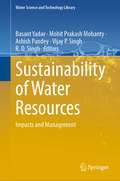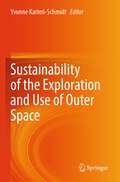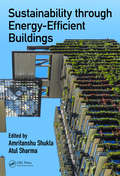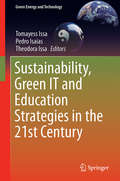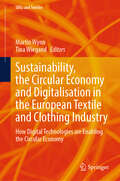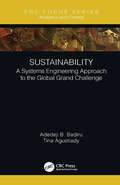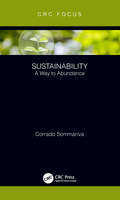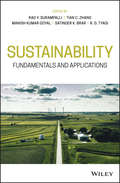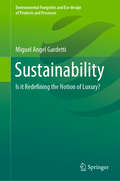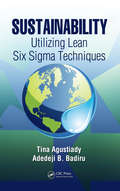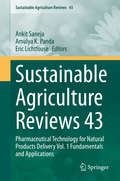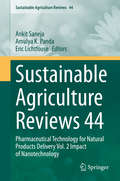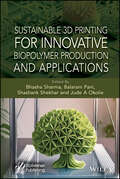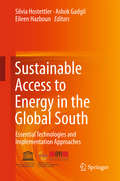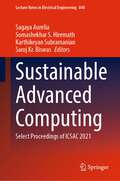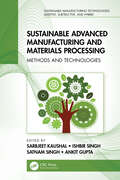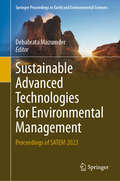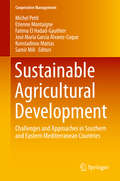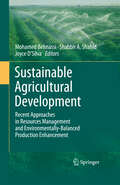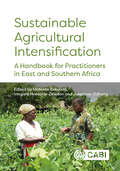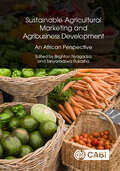- Table View
- List View
Sustainability of Water Resources: Impacts and Management (Water Science and Technology Library #116)
by Vijay P. Singh Ashish Pandey R. D. Singh Basant Yadav Mohit Prakash MohantyThis book covers a wide spectrum of water resources management, including water supply and demand, operation and maintenance of water distribution systems, water quality assessment, impacts of climate change on hydrological extremes, and water governance. Rapid urbanization, industrialization, and population growth are the major factors contributing to a significant rise in water demands across all the sectors in India. Although the Indian Summer Monsoon Rainfall contributes primarily to the available surface and groundwater resources, recurrent non-uniform/erratic rainfall events have resulted in widespread water scarcity. On many occasions, extreme meteorological conditions trigger the severity of water-related disasters such as floods and droughts. The untreated wastewater from domestic and industrial sources discharged through un-engineered means, adds to the issue as it ends up polluting the surface and groundwater resources.
Sustainability of the Exploration and Use of Outer Space
by Yvonne Karimi-SchmidtThis book provides insight into the significance of the law of outer space in promoting order, cooperation, and peaceful activities in space. It emphasizes the advantages of having a legal framework in place to govern space exploration and utilization, rather than relying on power and force.
Sustainability through Energy-Efficient Buildings
by Amritanshu Shukla and Atul SharmaThe book covers chapters ranging from introduction to recent technological challenges, case studies of energy-efficient buildings with policy and awareness issues, fundamentals and present status along with research updates and future aspects on topics focusing on energy-efficient construction, materials Provides comprehensive information on energy efficient buildings including policy and energy audit aspects with case studies Examines application of PCMs in passive heating and cooling in buildings; role of active TES and energy saving potential
Sustainability, Big Data, and Corporate Social Responsibility: Evidence from the Tourism Industry (Information Technology, Management and Operations Research Practices)
by Abdelli, Mohammed El AmineThis book aims to provide theoretical and empirical frameworks and highlights the challenges and solutions with using Big Data for Corporate Social Responsibility (CSR) and Sustainability in the field of digital transformation and tourism. Sustainability, Big Data, and Corporate Social Responsibility: Evidence from the Tourism Industry offers a theoretical and empirical framework in the field of digital transformation and applies it to the tourism sector. It discusses Big Data used with CSR and sustainability for the improvement of innovation and highlights the challenges and prospects. It presents a modern insight and approach for use by decision-makers as an application to solve various problems and explores how data collection can shed light on consumer behavior making it possible to account for existing situations and plan for the future. This book is intended to provide a modern insight for researcher, students, professionals, and decision-makers on the application of Big Data to improve CSR and sustainability in the tourism sector.
Sustainability, Green IT and Education Strategies in the Twenty-first Century
by Pedro Isaias Tomayess Issa Theodora IssaThis work presents and discusses the latest approaches and strategies for implementing Sustainability and Green IT into higher education and business environments. Following the global financial crisis in 2007/2008, businesses began to struggle coping with the increased IT/IS cost and their environmental footprint. As a consequence, action by universities to incorporate sustainability and ‘Green IT’ as parts of their teaching and learning materials, acknowledging their importance for global and local businesses, is being increasingly implemented. The book addresses the cooperation and coordination between academics and practitioners needed in order to achieve the changes required to obtain sustainability.Intended for researchers, lecturers and post-graduate students, as well as professionals in the Information Society and ICT and education sectors, and policy makers.
Sustainability, Innovation and Procurement (Advances in Mathematics and Engineering)
by Sunil Luthra Sachin Kumar ManglaSustainable procurement is the pursuit of sustainable development objectives through the purchasing and supply process, while balancing environmental, social, and economic objectives. This book will help readers develop new contemporary knowledge about frameworks, innovative tools and techniques to achieve sustainability in public as well as private procurement practices. The book will enable scholars and practitioners working in the domain of sustainable procurement to improve the overall performance of the supply chain and further achieve UN SDGs, by making various decisions at the planning and strategic phase of the business. Features Discusses theoretical, decision making and related business management models Assists to achieve Sustainable Development Goals (SDGs) Provides qualitative/quantitative frameworks Covers quality innovations sustainability in sourcing Examines measurement drivers, indicators and metrics
Sustainability, Stakeholders and Marketing in the Textile Sector: Conceptual and Practical Cases for the Americas (SDGs and Textiles)
by Aníbal Enrique Toscano-Hernández Saúl Alfonso Esparza-Rodríguez Gabino García-TapiaGeospatial analysis of the Sustainable Value Chain in the Textile sector of the United States.- Sustainable practices in the textile sector: Case study of the global value chain of the American economies.- Exploring eco-innovation performance in the textile industry: Case of two export-oriented Colombian firms.- Transformational and sustainable leadership in textile companies in Lima: a qualitative study.- Obstacles to innovation in textile SMEs in the Usaquen district of Bogota, Colombia 100 Reverse Logistics: A view from green capitalism and circular economy in textile companies in Mexico.- Green marketing strategies in sustainable fashion business models.- Green marketing and its contribution to the competitiveness of the textile and apparel sector. Case study in Cali.- The green swan´s theory and circular economy and it’s influence in regenerative capitalism.- Competitiveness of decent work of the us textile sector using a multivariable classification of the sdg 8 target 5: full employment and decent work.- Critical evaluation of successful strategies for sustainable manufacturing in the textile sector and their impact on the sustainable development goals: Case studies in Colombia.
Sustainability, the Circular Economy and Digitalisation in the European Textile and Clothing Industry: How Digital Technologies are Enabling the Circular Economy (SDGs and Textiles)
by Martin Wynn Tina WiegandThis book investigates the nature of the European textile and clothing industry, focusing on the relationship between sustainability practices, the transition to the circular economy and the deployment of digital technologies. It provides a profile of the industry in a range of European countries, allowing comparisons and contrasts, and the formulation of recommendations for future change and development. A mainly inductive, qualitative research approach is used, in which both secondary sources and primary interview and survey material are analysed to address key research questions, and support the development of a model for the assessment of companies in their transition to the circular economy, incorporating both upstream and downstream activities in the extended supply chain. The book will be of value to undergraduate and postgraduate students in environmental and computer technology disciplines, and to professionals and practitioners in the textile and clothing industry.
Sustainability: A Systems Engineering Approach to the Global Grand Challenge (Analytics and Control)
by Adedeji B. Badiru Tina AgustiadySustainability is one of the most embraced topics nowadays. Everybody is affected by issues of sustainability. Every organization needs to pay attention to these issues. As long as more people and more organizations are engaging in business and industry activities, there will always be a need for sustainability. This book presents tools such as lean six sigma to help sustain results by using process focused decisions. This book covers tools and techniques of industrial engineering to promote sustainability. It discusses a systems approach, the evolution of new products, development of sustainability alliances, and highlights the role of sustainability in advancing organizational goals. The book also addresses sustainability as a coordinated project using a project management approach. It includes the interface of humans and technology and presents an integration of analytics. The book is ideal for all engineering, business, and management fields.
Sustainability: A Way to Abundance
by Corrado SommarivaThe book describes mechanisms whereby the Earth naturally thrives towards energy and resources abundance and how unsustainable industrial practices alter this trend. Introduces the concept of earth energy and associates this to the conditions of the biosphere and emphasizes the possibilities with inexpensive wind and solar energy Provides a good quantification of the concepts of sustainability and its effects on the environmentn and critical analysis and updates to the relationships between the environmental impact, affluence and technology
Sustainability: Fundamentals and Applications
by Satinder K. Brar Rao Y. Surampalli Tian C. Zhang Manish Kumar Goyal R. D. TyagiA comprehensive resource to sustainability and its application to the environmental, industrial, agricultural and food security sectors Sustainability fills a gap in the literature in order to provide an important guide to the fundamental knowledge and practical applications of sustainability in a wide variety of areas. The authors – noted experts who represent a number of sustainability fields – bring together in one comprehensive volume the broad range of topics including basic concepts, impact assessment, environmental and the socio-economic aspects of sustainability. In addition, the book covers applications of sustainability in environmental, industrial, agricultural and food security, as well as carbon cycle and infrastructural aspects. Sustainability addresses the challenges the global community is facing due to population growth, depletion of non-renewable resources of energy, environmental degradation, poverty, excessive generation of wastes and more. Throughout the book the authors discuss the economics, ecological, social, technological and systems perspectives of sustainability. This important resource: • Explores the fundamentals as well as the key concepts of sustainability; • Covers basic concepts, impact assessment, environmental and socio-economic aspects, applications of sustainability in environmental, industrial, agricultural and food security, carbon cycle and infrastructural aspects; • Argues the essentiality of sustainability in ensuring the propitious future of earth systems; and • Authored by experts from a range of various fields related to sustainability. Written for researchers and scientists, students and academics, Sustainability: Fundamentals and Applications is a comprehensive book that covers the basic knowledge of the topic combined with practical applications.
Sustainability: Is it Redefining the Notion of Luxury? (Environmental Footprints and Eco-design of Products and Processes)
by Miguel Angel GardettiThis book presents and analyzes aspects that, within the framework of luxury, have been or are currently being redefined by sustainability considerations. It also presents and reviews cases from industry and entrepreneurs in connection with this ongoing redefinition process.
Sustainability: Utilizing Lean Six Sigma Techniques (Systems Innovation Book Series)
by Adedeji B. Badiru Tina AgustiadyAlthough most agree that Lean Six Sigma is here to stay, they also agree that learning how to sustain the results seems problematic at best and unattainable at worst. Reverting to the old way of doing things is inevitable if sustainability measures are not a part of the methodology. Currently there are no standard resource on how to be sustainable
Sustainable Agriculture Reviews 43: Pharmaceutical Technology for Natural Products Delivery Vol. 1 Fundamentals and Applications (Sustainable Agriculture Reviews #43)
by Eric Lichtfouse Ankit Saneja Amulya K. PandaThis edited book comprises of eight chapters dealing on various aspects of pharmaceutical technology for delivery of natural products. Book chapters deal with the solubility and bioavailability enhancement technologies for natural products. Emphasis has also been given on the significance of delivery strategies for improving the therapeutic efficacy of paclitaxel, galantamine and tea constituents.
Sustainable Agriculture Reviews 44: Pharmaceutical Technology for Natural Products Delivery Vol. 2 Impact of Nanotechnology (Sustainable Agriculture Reviews #44)
by Eric Lichtfouse Ankit Saneja Amulya K. PandaThis book covers nanotechnology based approaches for improving the therapeutic efficacy of natural products. It critically explores lipid nanoarchitectonics, inorganic particles and nanoemulsion based tools for delivering them. With its chapters from eminent experts working in this discipline, it is ideal for researchers and professionals working in the area.
Sustainable 3D Printing for Innovative Biopolymer Production and Applications
by Shashank Shekhar Bhasha Sharma Jude A. Okolie Balaram PaniThis book highlights 3D-printed biopolymers’ advancements and sustainability, exploring cutting-edge research and real-world applications. Biopolymers have garnered global interest due to environmental concerns and are widely utilized in applications such as biomedicine, food, textiles, and cosmetics. Techniques like 3D printing have been extensively studied to fabricate reliable and efficient products, particularly in tissue engineering. These techniques enable the production of materials with complex structures and diverse functional groups. The book provides a comprehensive account of contemporary advancements in 3D-printed biopolymers, emphasizing their role in promoting sustainability and supporting the circular economy. Featuring meticulously curated chapters by leading scientists, it integrates diverse disciplines, including green biopolymers, nanotechnology, functionalization techniques, and material synthesis, offering a holistic understanding of the field. Several chapters delve into 3D printing processing techniques and their applications in areas such as water purification, energy storage, and biomedical advancements. Additionally, the book addresses progress in biopolymer technology, exploring its challenges and future prospects. Audience This book is ideal for industrial manufacturers, environmental chemists, materials and biopolymer scientists, and researchers in industries such as biomedicine, food, textiles, packaging, and cosmetics.
Sustainable Access to Energy in the Global South
by Eileen Hazboun Silvia Hostettler Ashok GadgilPresenting the best papers of the 3rd EPFL-UNESCO Chair Conference on Technologies for Development, this publication offers a valuable collection of innovative case studies exploring access to energy and renewable energy technologies in the Global South. It investigates the key determinants for successfully providing energy to resource-poor communities and examines a wide range of technologies for energy production, distribution, storage and efficient use. Taken together, these case studies deal with the entire life cycle of products and solutions, as well as the complete value chain including all relevant stake holders. The collection also draws upon empirical research conducted in Africa and South America to present critical perspectives on women's access to technologies in the renewable sector. This publication serves as a bridge between engineers, economists and other scientists involved in research on the interface between technology and human, social and economic development. It also provides a valuable resource to academics and researchers of the natural sciences, computer science, information management, quantitative social sciences and business studies.
Sustainable Advanced Computing: Select Proceedings of ICSAC 2021 (Lecture Notes in Electrical Engineering #840)
by Somashekhar S. Hiremath Sagaya Aurelia Karthikeyan Subramanian Saroj Kr. BiswasThis volume presents select proceedings of the International Conference on Sustainable Advanced Computing (ICSAC – 2021). It covers the latest research on a wide range of topics spanning theory, systems, applications, and case studies in advanced computing. Topics covered are machine intelligence, expert systems, robotics, natural language processing, cognitive science, quantum computing, deep learning, pattern recognition, human-computer interface, biometrics, graph theory, etc. The volume focuses on the novel research findings and innovations of various researchers. In addition, the book will be a promising solution for new generation-based sustainable, intelligent systems that are machine and human-centered with modern models and appropriate amalgamations of collaborative practices with a general objective of better research in all aspects of sustainable advanced computing.
Sustainable Advanced Manufacturing and Materials Processing: Methods and Technologies (Sustainable Manufacturing Technologies)
by Ankit Gupta Sarbjeet Kaushal Ishbir Singh Satnam SinghThis book encapsulates and highlights the most recent innovations, breakthroughs, and comparisons of advanced sustainable manufacturing and material processing techniques for high-performance materials applications with a focus on sustainability and using conventional available methods. Sustainable Advanced Manufacturing and Materials Processing: Methods and Technologies addresses the various sustainable manufacturing and materials processing techniques for advanced materials. It discusses advancements in conventional and non-conventional techniques used in casting, joining, drilling, surface engineering, sintering, and composite manufacturing. The book focuses on a wide range of manufacturing techniques and materials processing technologies along with their benefits, limitations, and sustainability quotient. The conventional and advanced processes are compared in parallel to understand the need for advanced methods in manufacturing technology. This book is helpful to academic scholars and commercial manufacturers in giving them a first-hand source of information on sustainable manufacturing and material processing technology.
Sustainable Advanced Technologies for Environmental Management: Proceedings of SATEM 2023 (Springer Proceedings in Earth and Environmental Sciences)
by Debabrata MazumderThis proceedings volume constitutes peer-reviewed full-length papers contributed by the Authors and tailored on various thematic areas of the 1st International Conference on Sustainable Advanced Technologies for Environmental Management (SATEM – 2023). The areas of research covered by these papers include but are not limited to: •Sustainable Water Quality Management •Advanced Water Treatment Technologies •Advanced Wastewater Treatment Technologies •Assessment and Control of Air Pollution •Solid and Hazardous Waste Management •Prevention of Groundwater Contamination •Wetland Management/Phyto- and Phyco-remediation •Case Studies in Urban and Rural Pollution Control •Management of Emerging Contaminants •Innovative Techniques for measuring environmental pollutants
Sustainable Agricultural Chemistry in the 21st Century: Green Chemistry Nexus
by William M. NelsonAgriculture is one of the oldest and most global human enterprises, and as the world struggles with sustainable practices and policies, agricultural chemistry has a clear role to play. This book highlights the ways in which science in agriculture is helping to achieve global sustainability in the twenty- first century, and demonstrates that this science can and should be a leading contributor in discussions on environmental science and chemistry. The four drivers of this subject are presented, those being economic, environmental, regulatory and scientific, and help showcase agricultural chemistry as a dynamic subject that is contributing to this necessity of global sustainability in the twenty-first century.
Sustainable Agricultural Development
by Michel Petit Etienne Montaigne Fatima El Hadad-Gauthier José María García Álvarez-Coque Konstadinos Mattas Samir MiliThis book provides an up-to-date assessment of sustainable agri-food systems and rural development in the Mediterranean countries. It examines and reviews the impact of EU and national policies on environmental and trade issues in agricultural and rural organizations in the southern and eastern Mediterranean region. The book also reflects key socio-economic and political issues such as resource management, income distribution, employment and migration trends, and sustainability aspects. It demonstrates technical and methodological tools used for the analysis and explains their application. The book presents the collective work of a research consortium funded by an EU (FP7) project.
Sustainable Agricultural Development
by Shabbir A. Shahid Mohamed Behnassi Joyce D'SilvaDue to many challenges (i.e. climate change, energy, water and land shortage, high demands on food, land grabbing, etc.), agriculture production potential is expected to be seriously affected; thus, increasing food insecurity and hunger in many already affected regions (especially in Africa). In this context, sustainable agriculture is highly recommended as an eco-system approach where soil, water, plants, environment and living organisms live in harmony. Innovative technologies and research should be developed to ensure sustainable agriculture and productivity using modern irrigation systems, improved varieties, improved soil quality, etc. In the meantime, the preservation of natural environment should be based on resource conservation technologies and best management practices. Sustainable Agricultural Development, not only raises the serious ethical and social issues underlying these huge environmental problems, but also aims at presenting successful experiences from all over the world in relation with sustainable farming, sustainable management of water and land resources, and innovative processes in livestock production. It also aims at providing inputs to decision making processes and encouraging the transfer of relevant know-how, technologies and expertise to different countries where similar agro-climatic conditions may exist; thus saving precious resources and promoting sustainable agricultural development as a relevant approach to tackle the food security challenge. Finally, this book focuses on the paradigmatic and policy dimensions and call for an innovative approach by analyzing the key themes in a complex and interrelated manner.
Sustainable Agricultural Intensification: A Handbook for Practitioners in East and Southern Africa
by Mateete Bekunda Irmgard Hoeschle-Zeledon Jonathan OdhongThis book provides an insight into the background, lessons learned, and the methodology of facilitating the application of best-bet/best-fit agricultural technologies to smallholder farms in East and Southern Africa (ESA). All technologies highlighted within this book, except those on livestock feeding, were trialed and demonstrated in farmers' fields over an eight-year period [2012 - 2020] as part of the Feed the Future/USAID funded research-for-development Africa RISING ESA Project and supported by the CGIAR. The livestock feed technologies were compiled from Eastern Africa literature and included to offer a full set of technologies relevant for farmers in mixed farming systems. Topics covered include the introduction of resilient and nutrient-dense crops, better arrangement of crops in the field to amplify intercrop benefits, and the management of soils to improve soil fertility and minimize physical soil and nutrient loss. The publication also features technologies for postharvest loss reduction, livestock feeding, food processing, and in the later chapters, important expositions on how multiple technologies can be creatively integrated in a farming system and how key products of research can be taken to scale. In the first chapter and throughout the handbook, the importance of taking gender dynamics into account to ensure technologies produce equitable outcomes is emphasized. This book: provides evidence-based descriptions of sustainable agricultural intensification technologies that have been validated iteratively with smallholder farmers. a convenient, easy-to-read, and science-based 'how-to' guide for successful deployment of improved agricultural technologies that will ensure readers from development/scaling agencies save time and resources for research trials and instead focus on technology deployment. gives evidence of how building research and development partnerships can be a critical element for successful delivery and scaling up of agricultural technologies. The book is aimed primarily at development practitioners who seek new competences in taking new technologies to scale. However, the breadth of topics covered makes this book an essential resource for agricultural scientists as well as university and college students aspiring to apply systems thinking in future agricultural research and development work.
Sustainable Agricultural Marketing and Agribusiness Development: An African Perspective
by Emmanuel Ndhlovu Abimbola Oluyemisi Adepoju Abolupe Oluyemi Ayanboye Archeford Munyavhi Adenike Omotola Ajibobare Adulation Khayisano Ndlovu Basil Shumbanhete Benard Chisiri Benjamin Mudiwa Benson Ruzive Brenda Guruwo Charles Tsikada Dumisani Rumbidzai Muzira Ernest Mugoni Esther Mafunda Gibson Muridzi Gift Manhimanzi Godwin Shumba Jabulani Garwi Joseph P. Musara Julius Tapera Luckmore Marodza Maurice Kwembeya Moses Jachi Noah Ariel Mutongoreni Nyasha Nyakuchena Iscacle Nyanhete Oluwakemi Adeola Obayelu Patrick Korera Praise Zinhuku Purity Hamunakwadi Rahabhi Mashapure Reason Masengu Rumbidzai Pashapa Savanhu Howard Manyere Tafadzwa Machaka Tafadzwa Y. Chiwanza Thelma Lilian Munodawafah Wellington BandasonThe future of Africa and the whole globe is dependent on sustainable agribusiness management. This book offers insights to a wide range of agricultural marketing and agribusiness management practices with a focus on sustainability. It is designed to provide academics and graduate students in business studies with a comprehensive treatment of the nature of agricultural marketing and agribusiness management, as well as sustainability transitions and related practices in certain regions of the world (particularly in Africa). The text also serves as an invaluable resource for agricultural marketing practitioners requiring more than anecdotal evidence on the structure and operation of agricultural marketing and agribusiness management, as well as sustainability in different organisations and geographical areas. It allows the reader to compare and contrast agricultural marketing and agribusiness management, as well as sustainability practices across different research methodologies and settings. The book provides a unique mix of theory, reviews, primary research findings and case studies.
